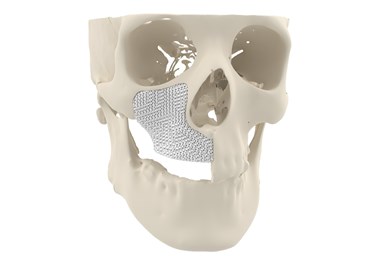Cerhum’s 3D Printed Bone Approved for Patients in Europe
The 3D printed bone is made of hydroxyapatite, a calcium phosphate which is the main mineral component of natural bone.
Cerhum’s MyBone is an implant 3D printed with a porous structure that enables ingrowth of blood vessels to treat patients with severe facial deformations. Photo Credit: Cerhum
Surgeons in Europe now have access to Cerhum’s MyBone, a patient-specific 3D printed bone, to treat patients with severe facial deformations. This 3D printed bone is made of hydroxyapatite, a calcium phosphate which is the main mineral component of natural bone. MyBone is 3D printed with a porous structure created by Cerhum, a medical device company based in Liège, Belgium.
The process is the first commercially available 3D printed bone graft authorized under the Medical Device Regulation 2017/745 (MDR), registered with the Belgium Competent Authority (FAMHP, registration number BE/CA01/1-72228) and ISO 13485 certified.
MyBone is made available to a first batch of maxillofacial and orthopaedic surgeons as a patient-specific implant. As part of a controlled release phase two years ago, surgeons treated a complex and challenging case in which the patient received a MyBone 3D printed bone implant. Surgeons report that the patient is still doing well and the implant looks exactly like natural bone on a recent CT scan.
“Given the complexity of the defect, it would have been impossible to achieve such perfection from an aesthetic point of view and such a functional result with current methods,” says Dr. Christophe Ronsmans, head of the plastic surgery department at Citadelle - Hôpital public de Liège.
Cerhum’s MyBone researchers have successfully gathered vital clinical data and passed all the regulatory hurdles with a synthetic bone graft that is safe and effective. “Our 3D printed bone implants offer a unique, patented porous structure that allows ingrowth of blood vessels,” says Grégory Nolens, Cerhum founder and CSO. “This process, called vascularisation, is key to achieve successful bone ingrowth. As a result, MyBone has shown 7 times faster bone ingrowth than currently available bone graft granules. Due to extremely positive feedback of maxillofacial surgeons so far, Cerhum is expanding its portfolio into the dental and oncological market.”
Founded in 2016, Cerhum (CERamics for HUMans) is a spinout from Sirris, the Belgian national Science and Technology Institute, and partner of the University of Liège, with the ultimate goal to replace autografts (bone taken from elsewhere in the patient). To date they have 3D printed 10,000-plus synthetic bone grafts for orthopedic companies that are used in orthopedic implants.
Related Content
-
Formlabs Expands SLA/SLS Ecosystem With New Materials, Postprocessing Tools
The new hardware, software and materials are designed to streamline postprocessing and unlock new workflows.
-
Video: AM for Harder, Longer-Lasting Brake Discs
Additive manufacturing is being applied to limit automotive brake dust. For a major automaker, Etxetar and Talens are developing a production-speed directed energy deposition system to give brake discs a precise layer of wear-resistant carbide.
-
Horizon Expands Services With Subcontract Micro AM Production, Design Support
Horizon also offers a suite of proprietary coating processes that enable customers to successfully expand the functionality of parts which are typically produced in plastics on commercially available micro additive manufacturing platforms.















